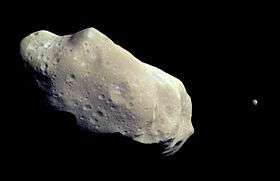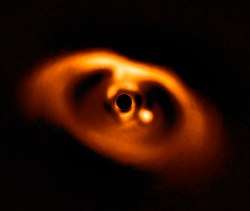Subsatellite
A subsatellite is a natural or artificial satellite that orbits a natural satellite, i.e. a "moon of a moon".
.tif.jpg)
It is inferred from the empirical study of natural satellites in the Solar System that subsatellites may be elements of planetary systems. In the Solar System, the giant planets have large collections of natural satellites. The majority of detected exoplanets are giant planets; at least one, Kepler-1625b, may have a very large exomoon, named Kepler-1625b I.[1][2][3][4] Therefore, it is reasonable to assume that subsatellites may exist in the Solar System and in other planetary systems.
Nonetheless, no "moon of a moon" or subsatellite is known as of 2018 in the Solar System or beyond. In most cases, the tidal effects of the planet would make such a system unstable.
Possible natural instances
Rhea

The possible detection[5] of a ring system around Saturn's natural satellite Rhea led to calculations that indicated that satellites orbiting Rhea would have stable orbits. Furthermore, the suspected rings are thought to be narrow,[6] a phenomenon normally associated with shepherd moons. However, targeted images taken by the Cassini spacecraft failed to detect any subsatellites or rings associated with Rhea of a size smaller than a few millimeters.[7]
Iapetus
It has also been proposed that Saturn's satellite Iapetus possessed a subsatellite in the past; this is one of several hypotheses that have been put forward to account for its unusual equatorial ridge.[8]
Artificial subsatellites
Many spacecraft have orbited the Moon, including crewed craft of the Apollo program. As of 2018, none have orbited any other moons. In 1988, the Soviet Union unsuccessfully attempted to put two robotic probes on quasi-orbits around the Martian moon Phobos.[9] Interplanetary spacecraft in development JUICE will enter orbit around Ganymede in 2032, becoming the first spacecraft to orbit a moon other than Earth's.
In fiction
The Elder Scrolls series of video games takes place on the planet of Nirn, orbited by the satellite Masser, which in turn is orbited by the subsatellite Secunda.
See also
- Binary asteroid
- Circumplanetary disk – moon-forming accumulation of particles around a planet
- Minor-planet moon
- Moons of Jupiter
- Moons of Neptune
- Moons of Saturn
- Moons of Uranus
References
- Forgan, Duncan (4 October 2018). "The habitable zone for Earthlike exomoons orbiting Kepler-1625b". arXiv:1810.02712v1 [astro-ph.EP].
- Chou, Felcia; Villard, Ray; Hawkes, Alison (3 October 2018). Brown, Katherine (ed.). "Astronomers Find First Evidence of Possible Moon Outside Our Solar System". Solar System and Beyond (Press release). NASA. Retrieved 11 October 2018.
- Drake, Nadia (3 October 2018). "Weird giant may be the first known alien moon - Evidence is mounting that a world the size of Neptune could be orbiting a giant planet far, far away". National Geographic Society. Retrieved 11 October 2018.
- "Hubble finds compelling evidence for a moon outside the Solar System". Hubble Space Telescope. 3 October 2018. Retrieved 11 October 2018.
- Jones GH, Roussos E, Krupp N, et al. (7 March 2008). "The Dust Halo of Saturn's Largest Icy Moon, Rhea". Science. 319 (5868): 1380–1384. Bibcode:2008Sci...319.1380J. doi:10.1126/science.1151524. PMID 18323452. Retrieved 12 October 2018.
- Hecht, Jeff (6 March 2008). "Saturn satellite reveals first moon rings". New Scientist. Retrieved 12 October 2018.
- Tiscareno, Matthew S.; Burns, Joseph A.; Cuzzi, Jeffrey N.; Hedman, Matthew M. (July 2010). "Cassini imaging search rules out rings around Rhea". Geophysical Research Letters. 37 (14): L14205. arXiv:1008.1764. Bibcode:2010GeoRL..3714205T. doi:10.1029/2010GL043663. Archived from the original on 2010-08-10.
- Fitzpatrick, Tony (13 December 2010). "How Iapetus, Saturn's outermost moon, got its ridge". the Source. Washington University in St. Louis. Retrieved 12 October 2018.
- Edwin V. Bell II (11 April 2016). "Phobos Project Information". NASA Space Science Data Coordinated Archive. NASA. Retrieved 2018-10-15.
External links
![]()
- Shadow Moons: The Unknown Sub-Worlds that Might Harbor Life
- Likely First Photo of Planet Beyond the Solar System
- Working Group on Extrasolar Planets – Definition of a "Planet" Position statement on the definition of a planet. (IAU)
- The Hunt for Exomoons with Kepler (HEK): I. Description of a New Observational Project


